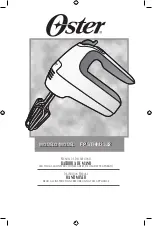
5
Installing shaft (Fig. 2 & 3)
Tighten the shaft into the shaft holder till the hex nut
contacts with the shaft holder.
Hold the shaft holder with the wrench and tighten the hex
nut with the other wrench in the direction of arrow.
Installing mixing blades (country specific) (Fig. 4
& 5)
To mount the mixing blade, install it with the “UP” mark
on it facing the tool (directing inside).
Install the mixing blade on the top of shaft and secure it
with hex bolt.
Installing top grip (auxiliary handle) (Fig. 6)
Screw the top grip on the tool securely.
Installing back grip (country specific) (Fig. 7 & 8)
Pull off the cap from the tool housing. Insert the leaf
springs into the groove of the handle part that has the
bosses. Then attach them to the bottom of the tool
housing.
Attach both of the handle parts and tighten them with the
screws securely.
OPERATION
Mixing (Fig. 9)
CAUTION:
• Do not use to mix flammable material such as paint
with thinner used as solvent. Failure to do so may
cause injury.
• Mixing with the mixing blade floating out of the mixing
material may cause the material to splash about.
1.
Always use the top or back grip (auxiliary handle)
and firmly hold the tool by top or back grip and
switch handle during operations.
2.
Place the mixing blade under material fully and turn
on the tool after making sure work site safety.
3.
Move the mixing blade up and down during the
mixing operation so that whole part of material can
be mixed.
4.
When finishing mixing, turn off the tool, make sure
that the mixing blade has come to a complete stop,
and then pull it out of the vessel.
MAINTENANCE
CAUTION:
• Always be sure that the tool is switched off and
unplugged before attempting to perform inspection or
maintenance.
• Never use gasoline, benzine, thinner, alcohol or the
like. Discoloration, deformation or cracks may result.
Replacing carbon brushes (Fig. 10 & 11)
Remove and check the carbon brushes regularly.
Replace when they wear down to the limit mark. Keep
the carbon brushes clean and free to slip in the holders.
Both carbon brushes should be replaced at the same
time. Use only identical carbon brushes.
Use a screwdriver to remove the brush holder caps. Take
out the worn carbon brushes, insert the new ones and
secure the brush holder caps.
To maintain product SAFETY and RELIABILITY, repairs,
any other maintenance or adjustment should be
performed by Makita Authorized Service Centers, always
using Makita replacement parts.
ENG905-1
Noise
The typical A-weighted noise level determined according
to EN60745:
Sound pressure level (L
pA
): 85 dB (A)
Sound power level (L
WA
): 96 dB (A)
Uncertainty (K): 3 dB (A)
Wear ear protection
ENG900-1
Vibration
The vibration total value (tri-axial vector sum) determined
according to EN60745:
Vibration emission (a
h
) : 2.5 m/s
2
or less
Uncertainty (K) : 1.5 m/s
2
ENG901-1
• The declared vibration emission value has been
measured in accordance with the standard test method
and may be used for comparing one tool with another.
• The declared vibration emission value may also be
used in a preliminary assessment of exposure.
WARNING:
• The vibration emission during actual use of the power
tool can differ from the declared emission value
depending on the ways in which the tool is used.
• Be sure to identify safety measures to protect the
operator that are based on an estimation of exposure in
the actual conditions of use (taking account of all parts
of the operating cycle such as the times when the tool
is switched off and when it is running idle in addition to
the trigger time).
ENH101-18
For European countries only
EC Declaration of Conformity
Makita declares that the following Machine(s):
Designation of Machine:
Mixer
Model No./ Type: MT660
Conforms to the following European Directives:
2006/42/EC
They are manufactured in accordance with the following
standard or standardized documents:
EN60745
The Technical file in accordance with 2006/42/EC is
available from:
Makita, Jan-Baptist Vinkstraat 2, 3070, Belgium
6.2.2014
Yasushi Fukaya
Director
Makita, Jan-Baptist Vinkstraat 2, 3070, Belgium






































